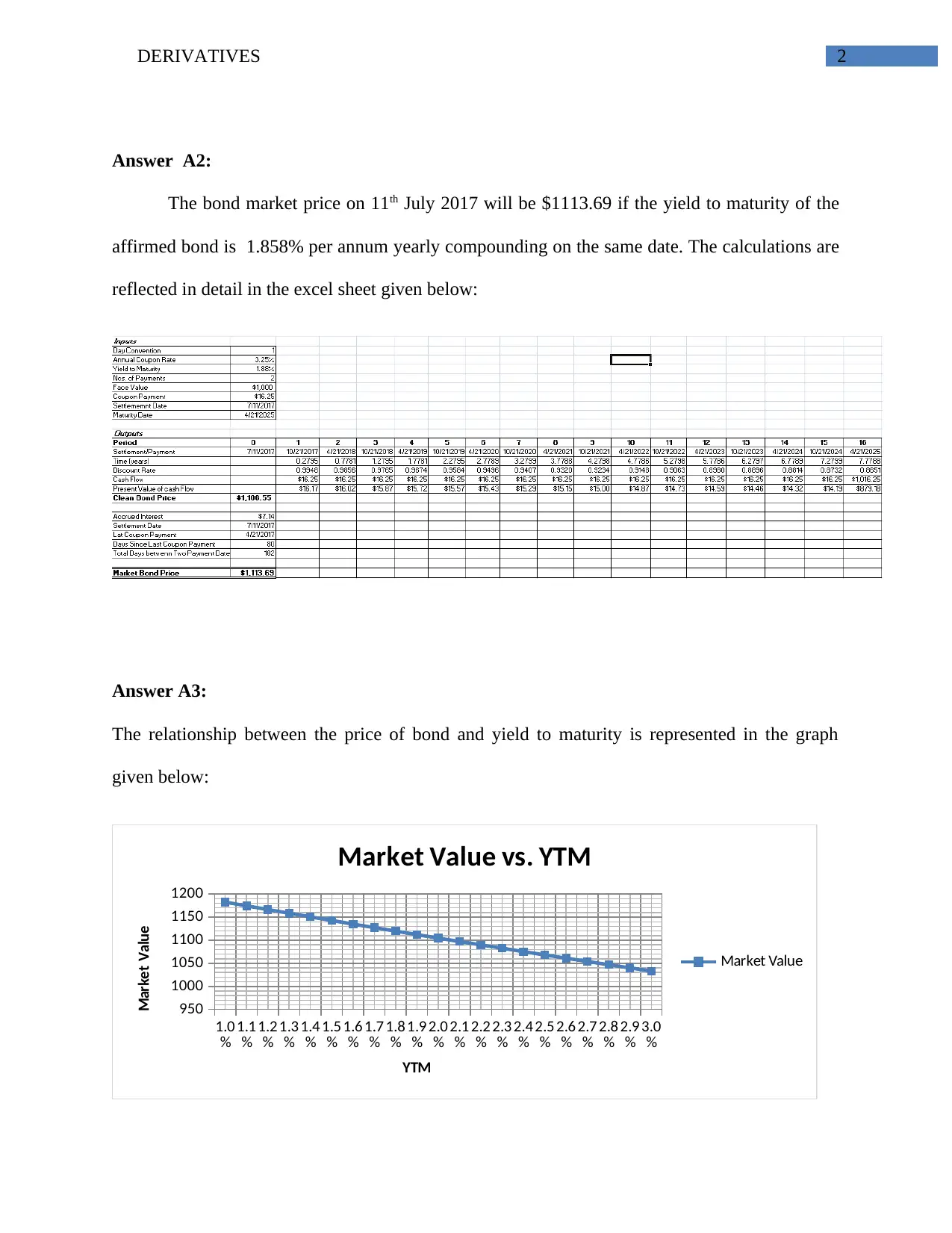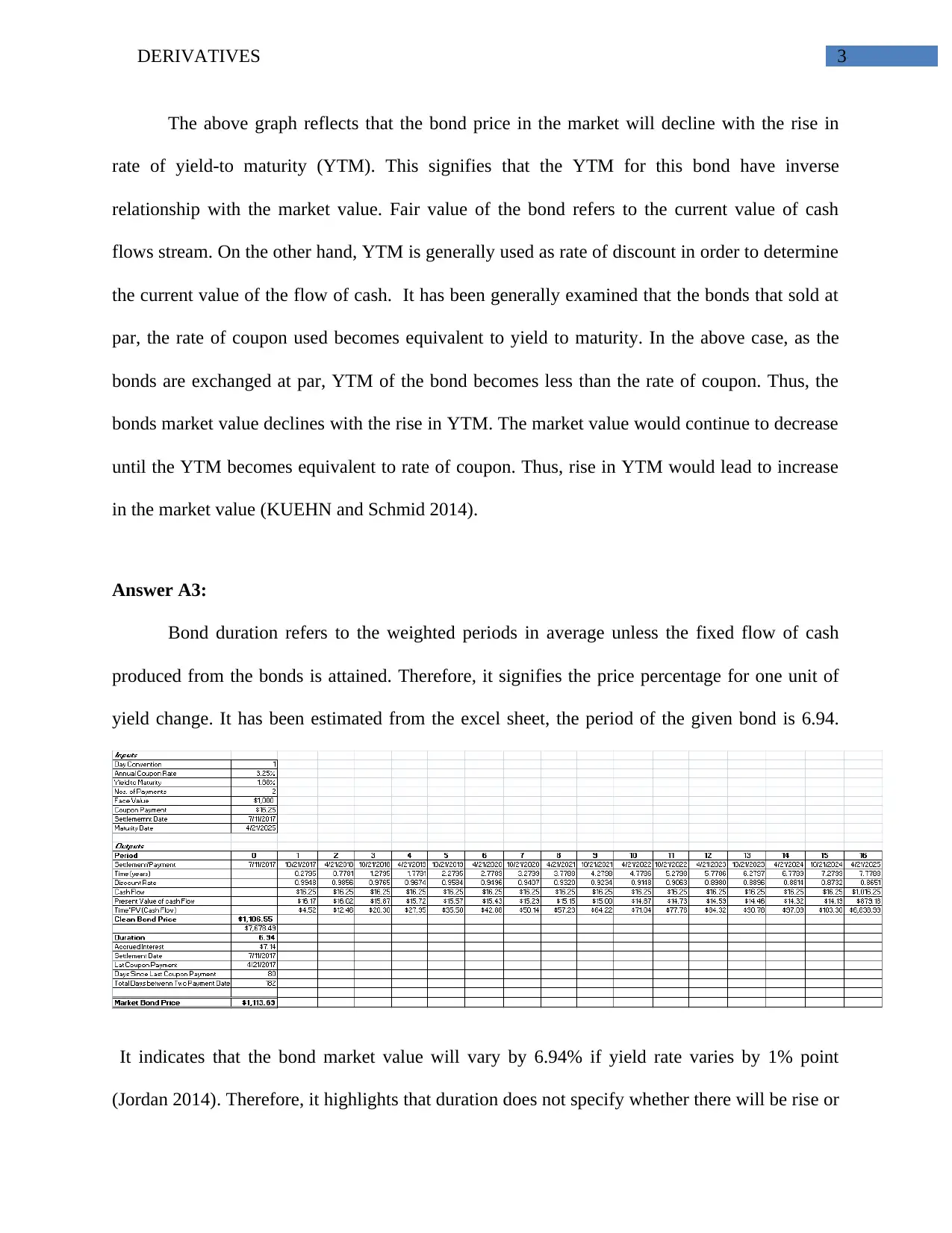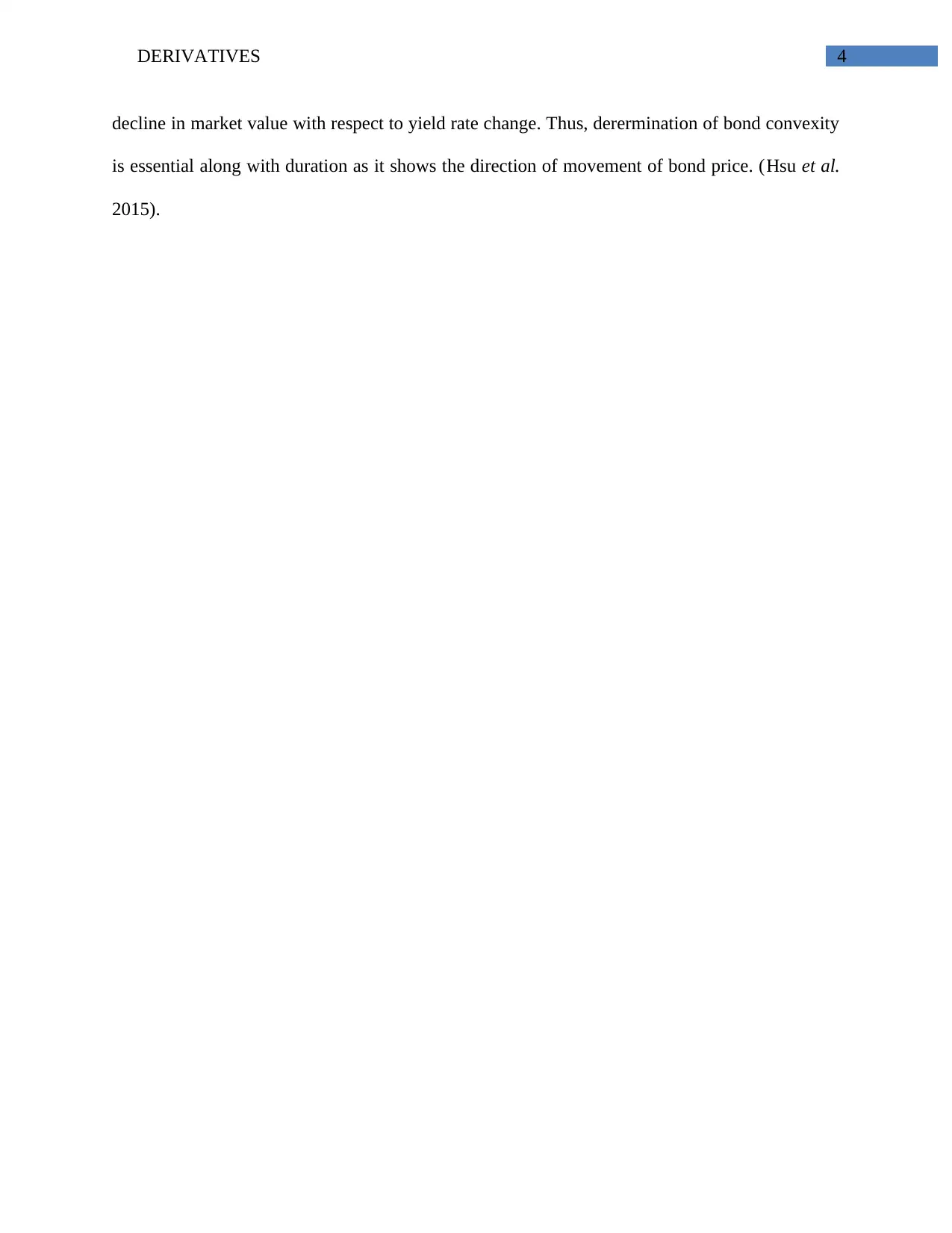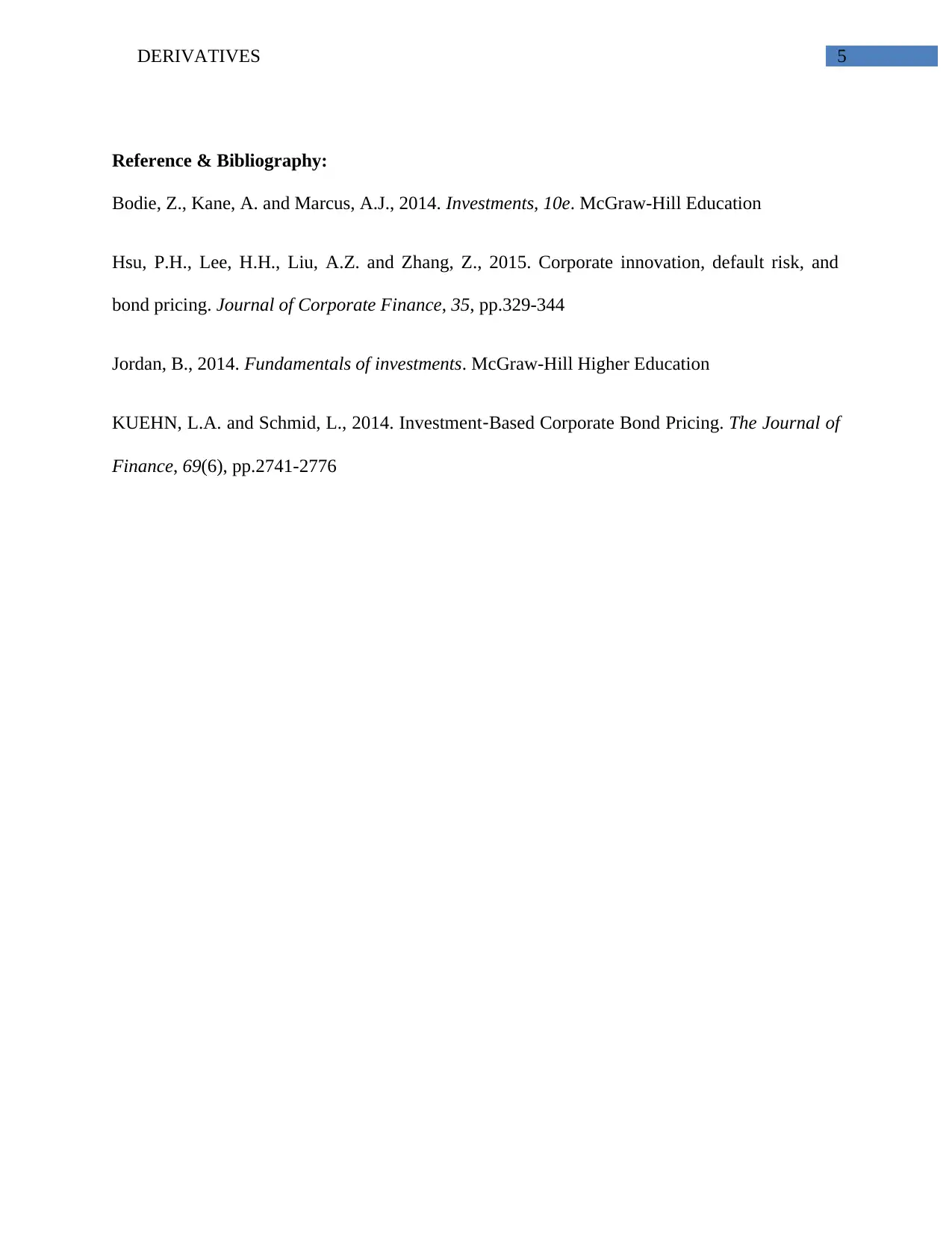Derivatives Solved Assignment
VerifiedAdded on 2019/11/19
|6
|533
|125
Homework Assignment
AI Summary
This homework assignment focuses on derivatives, specifically addressing bond pricing and the relationship between bond price and yield to maturity (YTM). The solution includes calculations demonstrating how to determine the bond market price given a specific YTM. A graph illustrates the inverse re...

Running head: DERIVATIVES
Derivatives
Name of the Student:
Name of the University:
Author’s Note:
Derivatives
Name of the Student:
Name of the University:
Author’s Note:
Paraphrase This Document
Need a fresh take? Get an instant paraphrase of this document with our AI Paraphraser

DERIVATIVES 1
Table of Contents
Answer A2:.....................................................................................................................................2
Answer A3:......................................................................................................................................2
Answer A3:......................................................................................................................................3
Reference & Bibliography:..............................................................................................................5
Table of Contents
Answer A2:.....................................................................................................................................2
Answer A3:......................................................................................................................................2
Answer A3:......................................................................................................................................3
Reference & Bibliography:..............................................................................................................5

DERIVATIVES 2
Answer A2:
The bond market price on 11th July 2017 will be $1113.69 if the yield to maturity of the
affirmed bond is 1.858% per annum yearly compounding on the same date. The calculations are
reflected in detail in the excel sheet given below:
Answer A3:
The relationship between the price of bond and yield to maturity is represented in the graph
given below:
1.0
% 1.1
% 1.2
% 1.3
% 1.4
% 1.5
% 1.6
% 1.7
% 1.8
% 1.9
% 2.0
% 2.1
% 2.2
% 2.3
% 2.4
% 2.5
% 2.6
% 2.7
% 2.8
% 2.9
% 3.0
%
950
1000
1050
1100
1150
1200
Market Value vs. YTM
Market Value
YTM
Market Value
Answer A2:
The bond market price on 11th July 2017 will be $1113.69 if the yield to maturity of the
affirmed bond is 1.858% per annum yearly compounding on the same date. The calculations are
reflected in detail in the excel sheet given below:
Answer A3:
The relationship between the price of bond and yield to maturity is represented in the graph
given below:
1.0
% 1.1
% 1.2
% 1.3
% 1.4
% 1.5
% 1.6
% 1.7
% 1.8
% 1.9
% 2.0
% 2.1
% 2.2
% 2.3
% 2.4
% 2.5
% 2.6
% 2.7
% 2.8
% 2.9
% 3.0
%
950
1000
1050
1100
1150
1200
Market Value vs. YTM
Market Value
YTM
Market Value
⊘ This is a preview!⊘
Do you want full access?
Subscribe today to unlock all pages.

Trusted by 1+ million students worldwide

DERIVATIVES 3
The above graph reflects that the bond price in the market will decline with the rise in
rate of yield-to maturity (YTM). This signifies that the YTM for this bond have inverse
relationship with the market value. Fair value of the bond refers to the current value of cash
flows stream. On the other hand, YTM is generally used as rate of discount in order to determine
the current value of the flow of cash. It has been generally examined that the bonds that sold at
par, the rate of coupon used becomes equivalent to yield to maturity. In the above case, as the
bonds are exchanged at par, YTM of the bond becomes less than the rate of coupon. Thus, the
bonds market value declines with the rise in YTM. The market value would continue to decrease
until the YTM becomes equivalent to rate of coupon. Thus, rise in YTM would lead to increase
in the market value (KUEHN and Schmid 2014).
Answer A3:
Bond duration refers to the weighted periods in average unless the fixed flow of cash
produced from the bonds is attained. Therefore, it signifies the price percentage for one unit of
yield change. It has been estimated from the excel sheet, the period of the given bond is 6.94.
It indicates that the bond market value will vary by 6.94% if yield rate varies by 1% point
(Jordan 2014). Therefore, it highlights that duration does not specify whether there will be rise or
The above graph reflects that the bond price in the market will decline with the rise in
rate of yield-to maturity (YTM). This signifies that the YTM for this bond have inverse
relationship with the market value. Fair value of the bond refers to the current value of cash
flows stream. On the other hand, YTM is generally used as rate of discount in order to determine
the current value of the flow of cash. It has been generally examined that the bonds that sold at
par, the rate of coupon used becomes equivalent to yield to maturity. In the above case, as the
bonds are exchanged at par, YTM of the bond becomes less than the rate of coupon. Thus, the
bonds market value declines with the rise in YTM. The market value would continue to decrease
until the YTM becomes equivalent to rate of coupon. Thus, rise in YTM would lead to increase
in the market value (KUEHN and Schmid 2014).
Answer A3:
Bond duration refers to the weighted periods in average unless the fixed flow of cash
produced from the bonds is attained. Therefore, it signifies the price percentage for one unit of
yield change. It has been estimated from the excel sheet, the period of the given bond is 6.94.
It indicates that the bond market value will vary by 6.94% if yield rate varies by 1% point
(Jordan 2014). Therefore, it highlights that duration does not specify whether there will be rise or
Paraphrase This Document
Need a fresh take? Get an instant paraphrase of this document with our AI Paraphraser

DERIVATIVES 4
decline in market value with respect to yield rate change. Thus, derermination of bond convexity
is essential along with duration as it shows the direction of movement of bond price. (Hsu et al.
2015).
decline in market value with respect to yield rate change. Thus, derermination of bond convexity
is essential along with duration as it shows the direction of movement of bond price. (Hsu et al.
2015).

DERIVATIVES 5
Reference & Bibliography:
Bodie, Z., Kane, A. and Marcus, A.J., 2014. Investments, 10e. McGraw-Hill Education
Hsu, P.H., Lee, H.H., Liu, A.Z. and Zhang, Z., 2015. Corporate innovation, default risk, and
bond pricing. Journal of Corporate Finance, 35, pp.329-344
Jordan, B., 2014. Fundamentals of investments. McGraw-Hill Higher Education
KUEHN, L.A. and Schmid, L., 2014. Investment‐Based Corporate Bond Pricing. The Journal of
Finance, 69(6), pp.2741-2776
Reference & Bibliography:
Bodie, Z., Kane, A. and Marcus, A.J., 2014. Investments, 10e. McGraw-Hill Education
Hsu, P.H., Lee, H.H., Liu, A.Z. and Zhang, Z., 2015. Corporate innovation, default risk, and
bond pricing. Journal of Corporate Finance, 35, pp.329-344
Jordan, B., 2014. Fundamentals of investments. McGraw-Hill Higher Education
KUEHN, L.A. and Schmid, L., 2014. Investment‐Based Corporate Bond Pricing. The Journal of
Finance, 69(6), pp.2741-2776
⊘ This is a preview!⊘
Do you want full access?
Subscribe today to unlock all pages.

Trusted by 1+ million students worldwide
1 out of 6
Related Documents
Your All-in-One AI-Powered Toolkit for Academic Success.
+13062052269
info@desklib.com
Available 24*7 on WhatsApp / Email
![[object Object]](/_next/static/media/star-bottom.7253800d.svg)
Unlock your academic potential
© 2024 | Zucol Services PVT LTD | All rights reserved.




